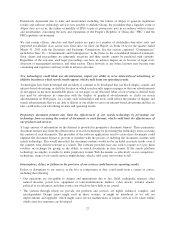Yahoo 2011 Annual Report Download - page 27
Download and view the complete annual report
Please find page 27 of the 2011 Yahoo annual report below. You can navigate through the pages in the report by either clicking on the pages listed below, or by using the keyword search tool below to find specific information within the annual report.Distribution agreements often involve revenue sharing. Over time competition to enter into distribution
arrangements may cause our traffic acquisition costs to increase. In some cases, we guarantee distributors a
minimum level of revenue and, as a result, run a risk that the distributors’ performance (in terms of ad
impressions, toolbar installations, etc.) might not be sufficient to otherwise earn their minimum payments. In
other cases, we agree that if the distributor does not realize specified minimum revenue we will adjust the
distributor’s revenue-share percentage or provide make-whole arrangements.
Some of our distribution agreements are not exclusive, have a short term, are terminable at will, or are subject to
early termination provisions. The loss of distributors, increased distribution costs, or the renewal of distribution
agreements on significantly less favorable terms may cause our revenue to decline.
More individuals are utilizing devices other than a PC to access the Internet, and versions of our services
developed for these devices might not gain widespread adoption by the devices’ users, manufacturers, or
distributors or might fail to function as intended on some devices.
The number of individuals who access the Internet through devices other than a PC, such as mobile telephones,
personal digital assistants, handheld computers, tablets, netbooks, televisions, and set-top box devices has
increased dramatically, and the trend is likely to continue. Our services were originally designed for rich,
graphical environments such as those available on PCs. The different hardware and software, memory, operating
systems, resolution, and other functionality associated with alternative devices currently available may make our
PC services unusable or difficult to use on such devices. Similarly, the licenses we have negotiated to present
third-party content to PC users may not extend to users of alternative devices. In those cases, we may need to
enter into new or amended agreements with the content providers in order to present a similar user-experience on
the new devices. The content providers may not be willing to enter into such new or amended agreements on
reasonable terms or at all.
We offer versions of many of our popular services (such as sports, finance, and news) designed to be accessed on
a number of models of alternative devices. We also offer versions of some of our services (such as instant
messaging) designed for specific popular devices. As new devices are introduced, it is difficult to predict the
problems we may encounter in developing versions of our services for use on those devices, and we may need to
devote significant resources to the creation, support, and maintenance of such versions or risk loss of market
share. If we are unable to successfully innovate new forms of Internet advertising for alternative devices, to
attract and retain a substantial number of alternative device manufacturers, distributors, content providers, and
users to our services, or to capture a sufficient share of an increasingly important portion of the market for these
services, we may be unsuccessful in attracting both advertisers and premium service subscribers to these
services.
To the extent that an access provider or device manufacturer enters into a distribution arrangement with one of
our competitors, or as our competitors design, develop, or acquire control of alternative connected devices or
their operating systems, we face an increased risk that our users will favor the services or properties of that
competitor. The manufacturer or access provider might promote a competitor’s services or might impair users’
access to our services by blocking access through their devices or by not making our services available in a
readily-discoverable manner on their devices. If competitive distributors impair access to our services, or if they
simply are more successful than our distributors in developing compelling products that attract and retain users or
advertisers, then our revenue could decline.
In the future, as new methods for accessing the Internet and our services become available, including through
alternative devices, we may need to enter into amended distribution agreements with existing access providers,
distributors, and manufacturers to cover the new devices and new arrangements. We face a risk that existing and
potential new access providers, distributors, and manufacturers may decide not to offer distribution of our
services on reasonable terms, or at all. If we fail to obtain distribution or to obtain distribution on terms that are
reasonable, we may not be able to fully execute our business plan.
25
























